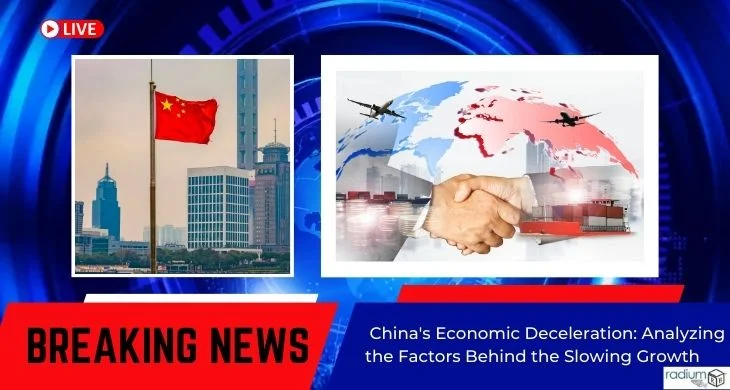China’s slowing economy refers to the deceleration of economic growth in China over a certain period. It is characterized by a decrease in the rate of expansion of the country’s Gross Domestic Product (GDP), which is a measure of the value of all goods and services produced in an economy. This slowdown can be influenced by various factors such as shifts in global demand, changes in domestic consumption patterns, adjustments in government policies, and external economic challenges.
GDP Growth in 2023
For the first time in decades, China’s GDP growth was lower than the global average in 2017. Since the start of 2023, the yuan has been losing ground to the dollar. S&P Global reported that it has lowered its 2023 GDP growth prediction for China as a result of May data showing that the post-COVID recovery in the world’s second-largest economy is stalling. Even though investment and industry are behind, China’s recovery should continue.
Factors for China’s slow growth:
- Shift in Economic Model: China is transitioning from an export-oriented, investment-driven economy to one that is more reliant on domestic consumption, which can lead to an adjustment period.
- Demographic Changes: China’s aging population and declining birth rate pose challenges for economic growth and workforce productivity.
- Debt Burden: China’s high levels of corporate and local government debt can constrain economic expansion and lead to financial risks.
- Trade Tensions: Trade conflicts with other countries, such as the United States, can disrupt global supply chains and impact China’s export-oriented sectors.
- Environmental Concerns: Efforts to address environmental issues and reduce pollution can lead to stricter regulations and impact certain industries.
- Structural Reforms: China is undergoing structural reforms to address issues like income inequality, financial sector reforms, and state-owned enterprise restructuring, which can temporarily affect growth.
- Technological Challenges: China faces challenges in transitioning to an innovation-driven economy and keeping pace with technological advancements.
The World Bank has published an economic update for China:
The resurgence in consumer demand is expected to drive China’s GDP growth, which is anticipated to reach 5.6% in 2023. It is anticipated that industrial and infrastructure investment would continue to be robust. As a result of the negative effects of export-restrictive global economy, external demand is anticipated to remain sluggish.
The prognosis for China’s growth is more vulnerable to negative factors. Consumer spending may be constrained by sluggish income growth, persisting doubts about the labor market’s revival, and excessive household precautionary saving. Although the real estate market is beginning to stabilise, excessive developer debt is still largely unresolved, and the sector’s continued weakness could hinder the economy’s recovery. External risks include dim expectations for global economic expansion, a greater than anticipated tightening of financial conditions, and escalating geopolitical tensions. A quicker job recovery might improve sentiment and lead to faster consumer growth, which would be positive.
Frequently Asked Questions:
Ques: What is causing China’s economic deceleration?
Ans: China’s economic deceleration is attributed to a combination of factors, including a shift in the economic model, demographic changes, high debt levels, trade tensions, environmental concerns, structural reforms, and technological challenges.
Ques: How is China transitioning its economic model?
Ans: China is shifting from an export-oriented, investment-driven economy to one that focuses more on domestic consumption and services sectors to sustain long-term growth.
Ques: What role do trade tensions play in China’s slow growth?
Ans: Trade tensions, particularly with the United States, have disrupted global supply chains, impacting China’s export-oriented sectors and causing uncertainty in international trade.
Ques: How does China’s aging population affect its economic growth?
Ans: China’s aging population and declining birth rate pose challenges for workforce productivity, pension systems, and the demand for goods and services.
Ques: What are the environmental concerns impacting China’s growth?
Ans: Efforts to address environmental issues and reduce pollution have led to stricter regulations, impacting industries that may not meet environmental standards.
Ques: How is China addressing its high debt levels?
Ans: China is taking measures to manage its high levels of corporate and local government debt through financial reforms, deleveraging efforts, and risk mitigation strategies.
Conclusion:
China’s economic deceleration is a result of various interconnected factors. The shift in the economic model, demographic changes, debt burden, trade tensions, environmental concerns, structural reforms, and technological challenges all contribute to the slowdown. It is a complex and evolving situation that requires careful management and policy adjustments. Understanding these factors is crucial for analyzing the challenges and implications of China’s slowing growth and for formulating strategies to foster sustainable and balanced economic development in the future.
Stay informed with the latest updates and breaking news, brought to you by radiumnews.

